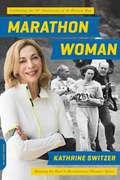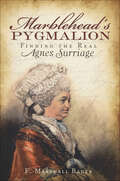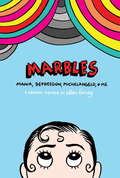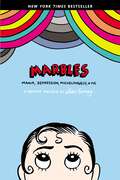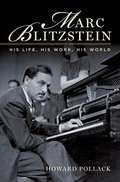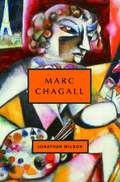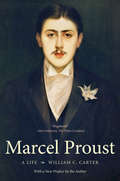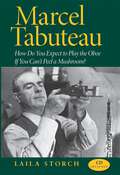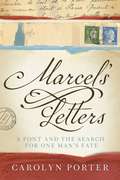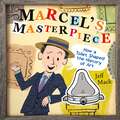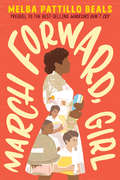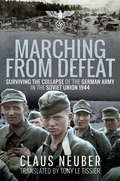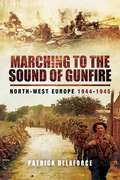- Table View
- List View
Marathon Swimming The Sport of the Soul: Inspiring Stories of Passion, Faith, and Grit
by Paul Andrew AsmuthWhen the plans and dreams of a young swimmer are shattered by the United States’ boycott of the 1980 Olympic Games in Moscow, God opens the door of new opportunities. For Paul Asmuth, then 22, it is the end of an unfulfilled dream, and the beginning of another journey, this one remarkable and life-changing. Plunging into the astounding, grueling, hypnotic, and often oddly beautiful world of international marathon swimming competitions, Asmuth experiences both triumph and tragedy, and, in a process as long and punishing as the marathon swims themselves, slowly discovers the best of himself. If you care for resumes, Asmuth is one of the most successful marathon swimmers in history. In the sapphire seas off Italy, in the frigid lakes of Quebec, Canada, in the marshy back bays of New Jersey, in the questionable waters ringing Manhattan, swimming distances from twenty to forty miles, Asmuth emerged victorious, often to thunderous acclaim. After multiple victories at the twenty-six-mile swim across Quebec’s Lac Memphremagog, up to 20,000 spectators would cheer and call him “le roi” (the king) of their lake. But true victory is not a matter of accolades or medals, and the stories that make a real difference unfold behind the headlines. Overcoming self-doubt, nausea, hypothermia, cruel tides and dark, watery shadows both real and imagined, Asmuth calls upon passion, iron-clad resolve, and steadfast faith to emerge a changed man, attaining success in its truest and most honest form. This success does not end when Asmuth retires from competing. Coming full circle, when he hangs up his swim suit, Paul takes the knowledge, lessons and examples he learned from his own experiences and some of the world’s greatest coaches, and turns to helping others with their swimming dreams. His prayers to give back are answered by coaching opportunities at multiple World Championships and two Olympic Games, where marathon swimming is now a contested event. But this is not just the tale of a swimmer. Like any great story, Paul’s transcends sport. By listening to the voice of faith and not of fear, new dreams are born, and God’s plans are revealed.
Marathon Woman: Running the Race to Revolutionize Women's Sports
by Kathrine SwitzerIn 1967, Kathrine Switzer was the first woman to officially run what was then the all male Boston Marathon, infuriating one of the event's directors who attempted to violently eject her. In what would become an iconic sports image, Switzer escaped and finished the race. This was a watershed moment for the sport, as well as a significant event in women's history.Including updates from the 2008 Summer Olympics, the paperback edition of Marathon Woman details the life of an incredible, pioneering athlete, and the lasting effect she's had on women's sports. Switzer's energy and drive permeate the pages of this warm, witty memoir as she describes everything from the childhood events that inspired her to succeed to her big win in the 1974 New York City Marathon, and beyond.
Marblehead's Pygmalion: Finding the Real Agnes Surriage
by F. Marshall BauerAgnes Surriage, it turns out, was more Pygmalion than Cinderella. Her role models were the fiercely independent "codfish widows, "? wives of the early Marblehead fishermen who managed home and family seven months a year without their husbands. In Agnes's version of My Fair Lady, she had to act as her own Henry Higgins while making the often painful transformation from "girl of all works"? at the Fountain Inn to the charming and dignified Lady Agnes, wife of Sir Charles Henry Frankland. After deconstructing the legend for twenty-five years, author F. Marshall Bauer has unearthed a story of money, lust and vindication.
Marbles: Mania, Depression, Michelangelo, And Me: A Graphic Memoir
by Ellen ForneyWashington Post's Top 10 Graphic Novels 2012'An unflinching and frequently unforgiving narrative of what it means to have bipolar disorder' - John Crace, Guardian'Marbles isn't just a great story; it's proof that artists don't have to be tortured to be brilliant.' - Entertainment WeeklyShortly before her thirtieth birthday, Forney was diagnosed with bipolar disorder. Suffering from (but enjoying) extreme mania, and terrified that medication would cause her to lose creativity, she began a long struggle over many years to find mental stability while retaining her creativity. Searching to make sense of the popular idea of the 'crazy artist', she finds inspiration from the lives and work of other artists and writers who suffered from mood disorders, including Vincent van Gogh, Georgia O'Keeffe, William Styron, and Sylvia Plath. She also researches the clinical aspects of bipolar disorder, including the strengths and limitations of various treatments and medications, and what studies tell us about the conundrum of attempting to "cure" an otherwise brilliant mind.Darkly funny and intensely personal, Forney's memoir provides a humorous but authentic glimpse into the effects of a mood disorder on an artist's work, as she shares her own story through black-and-white graphic images and prose.Written & illustrated by Ellen Forney - best known for her work on National Book Award-winning The Absolutely True Diary of a Part-Time Indian.
Marbles: Mania, Depression, Michelangelo, and Me: A Graphic Memoir
by Ellen ForneyCartoonist Ellen Forney explores the relationship between &“crazy&” and &“creative&” in this graphic memoir of her bipolar disorder, woven with stories of famous bipolar artists and writers. Shortly before her thirtieth birthday, Forney was diagnosed with bipolar disorder. Flagrantly manic and terrified that medications would cause her to lose creativity, she began a years-long struggle to find mental stability while retaining her passions and creativity. Searching to make sense of the popular concept of the crazy artist, she finds inspiration from the lives and work of other artists and writers who suffered from mood disorders, including Vincent van Gogh, Georgia O&’Keeffe, William Styron, and Sylvia Plath. She also researches the clinical aspects of bipolar disorder, including the strengths and limitations of various treatments and medications, and what studies tell us about the conundrum of attempting to &“cure&” an otherwise brilliant mind.Darkly funny and intensely personal, Forney&’s memoir provides a visceral glimpse into the effects of a mood disorder on an artist&’s work, as she shares her own story through bold black-and-white images and evocative prose.
Marc Blitzstein: His Life, His Work, His World
by Howard PollackA composer of enormous musical innovation and influence, Marc Blitzstein remains one of the most versatile and fascinating figures in the history of American music, his creative works running the gamut from operas, ballets, musicals, and film scores to orchestral works, chamber pieces, and artsongs. As an open homosexual and a prominent leftist, Blitzstein constantly pushed the boundaries of acceptability in mid-century America in both his music and his life. Award-winning music historian Howard Pollack's new biography is the first to put Blitzstein's music on equal footing with his politics, theatrical innovation, and other aspects of the composer's life. Pollack covers Blitzstein's life in full, from his childhood in Philadelphia to his violent deathin Martinique at age 58. The author describes how this student of contemporary luminaries Nadia Boulanger and Arnold Schoenberg became swept up in the stormy political atmosphere of the 1920s and 1930s and throughout his career walked the fine line between his formal training and his democraticprinciples. Indeed, Blitzstein developed a unique sound that drew on everything contemporary, from the high modernism of Stravinsky and Hindemith to blues, jazz, and musical comedy, and that profoundly influenced his younger friend Leonard Bernstein. Pollack captures the astonishing breadth ofBlitzstein's music - from politically controversial Broadway operas like The Cradle Will Rock and No for an Answer, to the patriotic Airborne Symphony, to such masterpieces as the opera Regina, to lesser known early pieces, film scores, and chamber works. A fearless artist, Blitzsteinadapted BertoltBrecht and Kurt Weill's The Threepenny Opera during the heyday of McCarthyism and the red scare, and with Weill's widow Lotte Lenya, turned it into an off-Broadway sensation. Beautifully written, drawing on new interviews with friends and family of the composer, and making extensive use of new archival and secondary sources, Marc Blitzstein presents the most complete biography of this quintessentially American composer.
Marc Chagall (Getting to Know the World's Greatest Artists)
by Mike VeneziaDiscusses the life and work of the artist Chagall, from his birth in Russia to his death at the age of ninety-seven.
Marc Chagall (Jewish Encounters Series)
by Jonathan WilsonNovelist and critic Jonathan Wilson clears away the sentimental mists surrounding an artist whose career spanned two world wars, the Russian Revolution, the Holocaust, and the birth of the State of Israel. Marc Chagall's work addresses these transforming events, but his ambivalence about his role as a Jewish artist adds an intriguing wrinkle to common assumptions about his life. Drawn to sacred subject matter, Chagall remains defiantly secular in outlook; determined to "narrate" the miraculous and tragic events of the Jewish past, he frequently chooses Jesus as a symbol of martyrdom and sacrifice. Wilson brilliantly demonstrates how Marc Chagall's life constitutes a grand canvas on which much of twentieth-century Jewish history is vividly portrayed. Chagall left Belorussia for Paris in 1910, at the dawn of modernism, looking back dreamily on the world he abandoned. After his marriage to Bella Rosenfeld in 1915, he moved to Petrograd, but eventually returned to Paris after a stint as a Soviet commissar for art. Fleeing Paris steps ahead of the Nazis, Chagall arrived in New York in 1941. Drawn to Israel, but not enough to live there, Chagall grappled endlessly with both a nostalgic attachment to a vanished past and the magnetic pull of an uninhibited secular present. Wilson's portrait of Chagall is altogether more historical, more political, and edgier than conventional wisdom would have us believe-showing us how Chagall is the emblematic Jewish artist of the twentieth century. Visit nextbook. org/chagall for a virtual museum of Chagall images. From the Hardcover edition.
Marc Marquez: Dreams Come True: My Story
by Freddie Spencer‘He has all the potential to become the greatest of all time’ Valentino Rossi, nine-time world championMarc Márquez is a phenomenon in the world of motorsports. In his first season in MotoGP, at the tender age of 20, he achieved the extraordinary by becoming the youngest world champion ever. He’s currently dominating in his second season, and is set to become the greatest the sport has ever seen. In his first official biography - fully-illustrated with many unseen photographs - Marc offers an exclusive insight into his first year racing in the premier class and his historic championship win. Through the words of his team, his family and his rivals for the title, we begin to understand the answer to his remarkable success. It’s the story of Marc’s greatest risks and challenges, from vision problems that put a halt on his career to the huge crash in May that saw him flying off his bike at a staggering speed of 175 mph. But Marc continues to rewrite history, earning titles with his fearless racing and winning fans with his boyish charm and famous smile – and smashing every record along the way.
Marcel Pronovost
by Marcel Pronovost Bob Duff"Marcel was the most underrated defenceman ever to play in the league. When he hit you, you were hit. He was a tremendous skater and defensively, he was as good as anyone. He might have been overlooked by the press, but he was never overlooked by his teammates. Years later, I brought him back to Detroit as a coach. He is very knowledgeable and a very astute observer of the game."-Hall of Fame left-winger Ted Lindsay (Pronovost's teammate from 1949-57 and 1964-65)In the spring of 1950, Marcel Pronovost was called up from the minor leagues to play for the Detroit Red Wings during the Stanley Cup playoffs. The 18-year-old defenceman had never seen NHL ice time before, but his performance in the playoffs was so impressive that he took regular turns in the final series against the New York Rangers. That year, Marcel Provonost became the ninth player in history to win a Stanley Cup before playing a single regular-season NHL game.So began Pronovost's 65-year career in pro hockey. As a Red Wing he became a star defenceman in Detroit's golden age, winning three more Stanley Cups between 1952 and 1955, and skating side-by-side with Gordie Howe, Ted Lindsay, and Terry Sawchuk (who became a lifelong friend). He played a pivotal role in the Toronto Maple Leafs' last Stanley Cup win in 1967. He earned recognition on the NHL's First and Second All-Star Teams. And he has continued to serve the game for decades, becoming one of the few NHLers to have success as a player, a coach, and as a scout.Now, with Marcel Pronovost: A Life in Hockey, this legendary defenceman and Hockey Hall of Famer tells these and other stories for the first time. With over 125 photos and with on-the-ice recollections from the most exciting Original Six Era games ever played, A Life in Hockey is a hard-hitting memoir, and an insider's take on playing, coaching, and scouting that spans seven decades, and surveys one of the longest hockey careers of all time. A must-have autobiography for Red Wings fans, Leafs fans, and hockey buffs everywhere.
Marcel Proust
by William C. CarterThis outstanding biography portrays in abundant detail the life and extraordinary times of Marcel Proust, one of the greatest literary voiced of the twentieth century. Based on a wealth of letters, memoirs, workbooks, and manuscripts unavailable before, the book examines Proust's character and development as an artist, the glittering Parisian world of which he was a part, and the passions that enabled him to write his masterpiece, In Search of Lost Time. Book jacket.
Marcel Proust: A Life
by Edmund WhiteIf there is anyone worthy of producing an intimate biography of the enigmatic genius behind Remembrance of Things Past, it is Edmund White, himself an award- winning writer for whom Marcel Proust has long been an obsession. <P><P>White introduces us not only to the recluse endlessly rewriting his one massive work through the night, but also the darling of Parisian salons, the grasper after honors, and the closeted homosexual-a subject this book is the first to explore openly. <P>From the frothiest gossip to the deepest angst, here is a moving portrait to be treasured by anyone looking for an introduction to this literary icon.
Marcel Tabuteau: How Do You Expect to Play the Oboe If You Can't Peel a Mushroom?
by Laila StorchLaila Storch is a world-renowned oboist in her own right, but her book honors Marcel Tabuteau, one of the greatest figures in twentieth-century music. Tabuteau studied the oboe from an early age at the Paris Conservatoire and was brought to the United States in 1905, by Walter Damrosch, to play with the New York Symphony Orchestra. Although this posed a problem for the national musicians' union, he was ultimately allowed to stay, and the rest, as they say, is history. Eventually moving to Philadelphia, Tabuteau played in the Philadelphia Orchestra and taught at the Curtis Institute of Music, ultimately revamping the oboe world with his performance, pedagogical, and reed-making techniques.In 1941, Storch auditioned for Tabuteau at the Curtis Institute, but was rejected because of her gender. After much persistence and several cross-country bus trips, she was eventually accepted and began a life of study with Tabuteau. Blending archival research with personal anecdotes, and including access to rare recordings of Tabuteau and Waldemar Wolsing, Storch tells a remarkable story in an engaging style.
Marcel's Letters: A Font and the Search for One Man's Fate
by Carolyn PorterFinalist for the 2018 Minnesota Book AwardA graphic designer’s search for inspiration leads to a cache of letters and the mystery of one man’s fate during World War II.Seeking inspiration for a new font design in an antique store in small-town Stillwater, Minnesota, graphic designer Carolyn Porter stumbled across a bundle of letters and was immediately drawn to their beautifully expressive pen-and-ink handwriting. She could not read the letters-they were in French-but she noticed all of them had been signed by a man named Marcel and mailed from Berlin to his family in France during the middle of World War II.As Carolyn grappled with designing the font, she decided to have one of Marcel’s letters translated. Reading it opened a portal to a different time, and what began as mere curiosity quickly became an obsession with finding out why the letter writer, Marcel Heuzé, had been in Berlin, how his letters came to be on sale in a store halfway around the world, and, most importantly, whether he ever returned to his beloved wife and daughters after the war.Marcel’s Letters is the incredible story of Carolyn’s increasingly desperate search to uncover the mystery of one man’s fate during WWII, seeking answers across Germany, France, and the United States. Simultaneously, she continues to work on what would become the acclaimed P22 Marcel font, immortalizing the man and his letters that waited almost seventy years to be reunited with his family.
Marcel's Masterpiece: How a Toilet Shaped the History of Art
by Jeff MackAn engaging, kid-friendly introduction to artist Marcel Duchamp and how he turned a toilet into a famous work of art.This is the story of Marcel Duchamp and how the Dada art movement changed the way people thought about what art could be, and what could be art. From drawing a moustache on the Mona Lisa to attaching a bicycle wheel to a stool, Duchamp's work challenged long-held notions of art and how it should be made. People were amused, confused, and sometimes offended, and that was just the way Marcel Duchamp liked it.With Marcel's Masterpiece, Jeff Mack explores Duchamp's most famous provocation, and asks readers to ponder the ideas that help us see the world in new and interesting ways.
March Forth
by Trevor Greene Debbie GreeneAt the age of forty-one, Trevor Greene, a journalist and a reservist in the Canadian Forces, was deployed to Afghanistan, leaving behind his fiance, Debbie, and his young daughter, Grace. On March 4, 2006, while meeting with village elders in a remote village in Kandahar Province, Trevor removed his helmet, confident that a centuries-old pact would protect him from harm. Without warning, a teenage boy under the influence of the Taliban walked up to him and landed a rusty axe in his skull, nearly splitting his brain in two. Initially, Debbie was told that Trevor would not survive. When he did, she was told that he would never be able to communicate or move on his own. But after years of rehabilitation, setbacks and crises, Trevor not only learned how to talk and move again, but in July 2010, he stood up at his wedding, Debbie at his side and Grace carrying their rings down the aisle as their flower girl. March Forth is a remarkable story of love told in two voices: first in Trevor's, up until the attack; then in Debbie's, as she works tirelessly to rehabilitate her fiance. Together, Trevor and Debbie have written the next chapter in their remarkable story.
March Forward, Girl: From Young Warrior to Little Rock Nine
by Melba Pattillo Beals Frank MorrisonFrom the legendary civil rights activist and author of the million-copy selling Warriors Don't Cry comes an ardent and profound childhood memoir of growing up while facing adversity in the Jim Crow South. Long before she was one of the Little Rock Nine, Melba Pattillo Beals was a warrior. Frustrated by the laws that kept African-Americans separate but very much unequal to whites, she had questions. Why couldn’t she drink from a "whites only" fountain? Why couldn’t she feel safe beyond home—or even within the walls of church? Adults all told her: Hold your tongue. Be patient. Know your place. But Beals had the heart of a fighter—and the knowledge that her true place was a free one. Combined with emotive drawings and photos, this memoir paints a vivid picture of Beals’ powerful early journey on the road to becoming a champion for equal rights, an acclaimed journalist, a best-selling author, and the recipient of this country’s highest recognition, the Congressional Gold Medal.
March Past: The Memoir of a Commando Leader, From Lofoten to Dieppe & D-Day
by Lord LovatAt the outbreak of war in 1940, Simon Frazer, the 15th Lord Lovat and a former Guards officer, was mobilized from the reserve list to join the Lovat Scouts, the British Army’s first sniper unit that had been formed by his father during the Boer War. The following year he volunteered for one of the new Commando units then being created. Lovat was personally involved in the training of the Commando troops on the West coast of Scotland. He was eventually attached to, and led, No.4 Commando. On 3 March 1941, Nos. 3 and 4 Commando launched a raid on the German-occupied Lofoten Islands. In this successful attack, Operation Claymore, the commandos destroyed fish-oil factories, petrol dumps, and even eleven ships. They also seized encryption equipment and codebooks, as well as captured 216 German troops. Promoted to temporary major, Lovat led 100 men of No.4 Commando and a 50-man detachment from the Canadian Carleton and York Regiment in a raid on the French coastal village of Hardelot in April 1942. For this action he was awarded the Military Cross on 7 July that year. Lord Lovat was involved in further raids against the German-held French coast, most notably Dieppe, during which No.4 Commando destroyed the coastal battery at Varengeville-sur-Mer in a textbook commando attack. This resulted in Lovat being awarded the DSO. Such was the effect the Commando raids had on German morale, Lovat had 100,000 Reichmarks placed on his head, dead or alive. Promoted to brigadier, Lovat formed the 1st Special Service Brigade (later the 1st Commando Brigade) which stormed ashore on D-Day to secure the eastern flank of the attacking forces. In this, he famously instructed his personal piper, Bill Millin, to pipe the commandos and himself ashore, in defiance of specific orders not to allow such an action in battle. In the subsequent fighting Lovat was seriously wounded, effectively ending his active career. These are the memoirs of one of the most remarkable fighting figures of the Second World War, who was involved in some its more exciting and dangerous operations. Despite his aristocratic ancestry, he led from the front and, without doubt, Simon Frazer, Lord Lovat was a soldiers’ soldier.
March of the Suffragettes: Rosalie Gardiner Jones and the March for Voting Rights
by Zachary Michael JackMarch of the Suffragettes tells the forgotten, real-life story of "General" Rosalie Gardiner Jones, who in the waning days of 1912 mustered and marched an all-women army nearly 200 miles to help win support for votes for women. General Jones, along with her good friends and accomplices "Colonel" Ida Craft, "Surgeon General" Lavinia Dock, and "War Correspondent" Jessie Hardy Stubbs, led marchers across New York state for their pilgrims' cause, encountering not just wind, fog, sleet, snow, mud, and ice along their unpaved way, but also hecklers, escaped convicts, scandal-plagued industrialists on the lam, and jealous boyfriends and overprotective mothers hoping to convince the suffragettes to abandon their dangerous project. By night Rosalie's army met and mingled with the rich and famous, attending glamorous balls in beautiful dresses to deliver fiery speeches; by day they fought blisters and bone-chilling cold, debated bitter anti-suffragists, and dodged wayward bullets and pyrotechnics meant to intimidate them. They composed and sang their own marching songs for sisterhood and solidarity on their route, even as differences among them threatened to tear them apart. March of the Suffragettes chronicles the journey of four friends across dangerous terrain in support of a timeless cause, and it offers a hopeful reminder that social change is achieved one difficult, dauntless, daring step at a time.
Marching Along: Recollections of Men, Women and Music
by John Philip Sousa Paul E. BierleyMarching Along is the intriguing autobiography John Philip Sousa wrote in the final years of his life. Sousa (1854-1932) was America's first superstar, a giant of his day. He conducted more than 14,000 concerts, composed a hundred hit tunes, and wrote three Broadway musicals that ran at the same time. In 1900 he was the best-known musician in the world, friends with presidents, corporate giants, and movie stars. Marching Along contains the amusing and insightful reflections of a world-class musician who charmed audiences around the globe for half a century yet also reveals the man's humble nature as a simple lover of music. This book brings the colorful story of the March King and his music into true focus in an engaging and entertaining way. It is sure to bring every reader, musician or not, insights into the man who dominated the musical scene of early twentieth-century America.
Marching from Defeat: Surviving the Collapse of the German Army in the Soviet Union 1944
by Claus NeuberIn this WWII memoir, a Nazi soldier recounts his desperate retreat from Russia, offering rare insight into the collapse of Hitler’s Army Group Central.In June of 1944, the Red Army launched a massive offensive that crushed Hitler’s forces in Belarus. German soldiers who weren’t captured had to fight their way back towards their own lines across hundreds of miles of enemy territory. This is the story of one of them, Claus Neuber, a young artillery officer who describes in graphic detail his experiences during that great retreat.Neuber’s account carries the reader through the desperate defensive battles and rearguard actions fought to stem the relentless Soviet advance and breakout from the cauldrons between Minsk and the Beresina river. After almost seventy days as a fugitive, depending on the kindness of villagers, enduring extremes of cold, wet and hunger, Neuber found his way back to the German lines. This personal narrative, translated for the first time from the original German, gives a dramatic insight into the impact of the Soviet offensive and the disintegration of an entire German army. It vividly records in day-to-day detail the experience of such a bitter defeat.
Marching to Freedom: The Story of Martin Luther King, Jr. (Famous Lives)
by Joyce MiltonA biography of the Baptist minister and civil rights leader whose practice of nonviolent civil disobedience helped African Americans win many battles for equal rights.
Marching to the Drums: Eyewitness Accounts of War from the Kabul Massacre to the Siege of Mafeking
by Ian KnightIn this gripping collection of first-hand accounts, Ian Knight presents the adventure of nineteenth-century warfare from the thrill of the cavalry charges at Balaklava and Omdurman, to the terror of battle against an overwhelming odds such as Rorke's Drift in the words of the men actually there.These eyewitness accounts provide a vivid and sometimes shocking insight into the brutal realities of warfare for the British imperial soldier, who fought against enemies from massed ranks of Russians and assegai-armed natives to sharp-shooting Boers, in often the most terrible conditions imaginable.These stirring tales of military adventure have been edited by Ian Knight and brought together and published in book form. Originally featured in turn-of-the-century magazine, popular during the heyday of empire, these historically valuable accounts throw considerable light on campaign conditions during Queen Victoria's colonial wars.Marching to the Drums includes accounts focusing on the experience of battle during such pivotal conflicts as the Sikh Wars, the Crimean War, the Afghan Wars, the Anglo-Zulu War, and those in China, the Sudan and South Africa.
Marching to the Mountaintop: How Poverty, Labor Fights and Civil Rights Set the Stage for Martin Luther King Jr's Final Hours
by Ann BausumIn early 1968 the grisly on-the-job deaths of two African-American sanitation workers in Memphis, Tennessee, prompted an extended strike by that city's segregated force of trash collectors. Workers sought union protection, higher wages, improved safety, and the integration of their work force. Their work stoppage became a part of the larger civil rights movement and drew an impressive array of national movement leaders to Memphis, including, on more than one occasion, Dr. Martin Luther King, Jr.King added his voice to the struggle in what became the final speech of his life. His assassination in Memphis on April 4 not only sparked protests and violence throughout America; it helped force the acceptance of worker demands in Memphis. The sanitation strike ended eight days after King's death.The connection between the Memphis sanitation strike and King's death has not received the emphasis it deserves, especially for younger readers. Marching to the Mountaintop explores how the media, politics, the Civil Rights Movement, and labor protests all converged to set the scene for one of King's greatest speeches and for his tragic death.National Geographic supports K-12 educators with ELA Common Core Resources.Visit www.natgeoed.org/commoncore for more information.
Marching to the Sound of Gunfire: North-West Europe, 1944–1945
by Patrick DelaforceIn this exciting and revealing book, scores of British soldiers tell their amazing stories of life and death in the front line of the Allies' advance from Normandy to Hitler's Germany. In eleven months of bitter fighting between D-Day and VE Day the combined efforts of the British and their allies' armed forces ground down their ruthless enemy in the pursuit of victory. Each and every man has a unique story to tell, whether they were infantry, tank crews, gunners, sappers or in vital logistic and supporting units. Theirexperiences make for powerful and fascinating reading. First-hand accounts of the landings, liberation of towns and villages, fierce actions, not all successful, bring home to the reader the cost of war as well as the magnitude of the venture. Particularly evocative is the range of emotions that were experienced by those involved, be they generals or the most junior soldiers. The passage of time means that many of these 'voices' will be heard no more but fortunately Marching to the Sound of Gunfire captures their inspiring testimonies for posterity.

